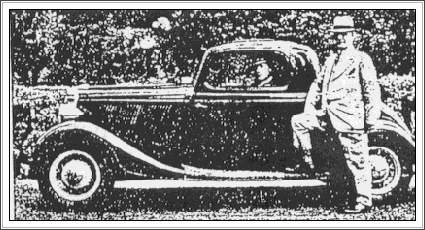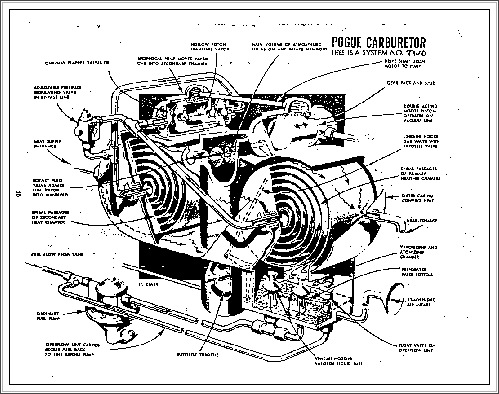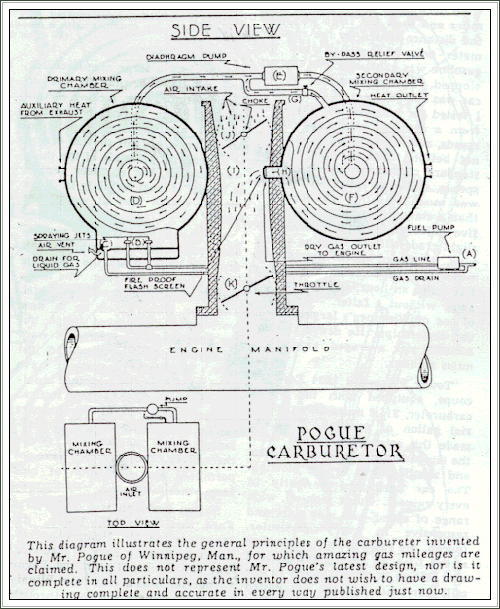



email author of himac website J Bruce McBurney.
This was reprinted from Canadian Automotive Trade Magazine from May 1936. Sensationalism Performance Seen In Pogue Carburetor Tests

By Herb C. Braund.
Sensational as it is to the public, who are beginning to grasp the enormous possibilities if the device as it is reported, the Pogue carburetor is an old story to Charles Nelson Pogue. He has been working on it for 17 years, the past l0 teamed up with his backer, W.J. Holmes, prominent Winnipeg business man.
Both these men are quiet and reticent about the device. Trials which they permitted some Winnipeg men to make were the means of the news reaching the public. The inventor and his backer still consider the device was prematurely announced, although they claim they were achieving the remarkable economy of 75 miles to the gallon back in l927.
No one has been allowed to examine the details of the working model. Not even those who might be considered possible purchasers have seen its interior. They have been permitted to test it, to give it every possible test on the road, and they all admit they were staggered by the results. They are convinced Mr. Pogue "has something". They still do not know exactly what it is.

Here are some of the results:
" Without question he proved is a reality, gives 25.6 miles on a pint of ordinary gasoline". Sales manager of one of the large Canadian motor car manufacturers. Speed of the car on this test was from 2 to 70 m.p.h.
" At the time the test was made, we covered 25.7 miles on one pint of gasoline. Before starting the test, the car was run until the motor stalled for want of fuel. The pint of gas was then connected, the main supply turned off, and the test started from the stalled motor. We are at a loss to understand the reason for such marked economy, however every consideration was shown in carrying out test." Representative of engineering department of another large Canadian car manufacturer. Speeds on the test varied from 1 to 70 miles an hour. He drove the car personally.
I made a test today of the Pogue carburetor installed on a Ford eight cylinder coupe. The speedometer showed the car had already run over 8,000 miles. I drove the car 26.2 miles on one pint of gasoline.
The temperature was averaging around zero with a strong north wind blowing. I drove south for 15 mules and back the same way, and the distance shown on the speedometer was 26.2 miles when the gasoline was exhausted and the car stopped. The performance of the car was 100 percent in every way.
I tested for acceleration, get-away from a standing start, and at all speeds, and it performed equal to, if not better, than any car with a standard carburetor. At very slow speeds, under 10 miles an hour, it was much smoother in operation than a standard car.
In fact, below 5 miles an hour it pulled up a slight grade without laboring of any kind. I stepped on the accelerator, when the speedometer was below five miles an hour, and the car got away without a falter."
President of one of Winnipeg's largest motor car dealerships. He drove the car himself and averaged around 45 miles an hour.
"Today I Drove A 1934 V8 coupe, equipped with the Pogue carburetor 216.8 miles on an imperial gallon of gasoline.
This car made this astounding record when the temperature was 10 below zero, and a stiff north east breeze blowing. The car performed perfectly in every respect. Quick pick up, wide range of speed, and was alert and responsive in every particular.
Indeed, the car was so flexible that at one time, on very slight grade, I was able to throttle it down to one mile per hour and the car pulled along smoothly and steadily"
-The manager of another of Winnipeg largest motor agencies. He drove at speeds up to 45 miles per hour.
The writer submitted the accompanying drawing to a competent Engineer, representing a Large manufacturer and pointed out that it was an incomplete drawing, lacking certain essential parts, and not accurate as to sizes, etc.
Means of regulation, for instance are not shown. Asked if the general principle of the thing was feasible, the engineer replied at once; " it most certainly is. I can see no reason why it would not work."

Mr. Pogue gave the writer personally permission to publish this drawing to illustrate the principle he has been developing. The illustration shows a previous model. The one with which he is now working on is an improved design, but for good reasons he does not want an accurate model reproduced just now.
Elaborate precautions have been taken to make sure that absolute patent coverage has been secured though out the world. The owners of the invention propose to manufacture and market the device themselves.
They say they have not permitted the submission of bids from other interests.
Shown herewith {just a photo of 2 guys and a old car, not worth up loading} is a photo of a Ford car, with Mr. C.N. Pogue, the inventor, and Mr. W. J. Holmes, Backer, taken in Stanley Park Vancouver. The car equipped with the Pogue carburetor, was driven from Winnipeg to Vancouver and back through the mountains. Mr. Pogue says the car consumed 14 1/2 gallons of gasoline in 1,879 1/2 miles, While another car, equipped with a standard carburetor, Used 106 1/2 gallons to cover the same distance.
That was in June and July, 1935 and they say mileage has been considerably increased since then.
The general principle can be grasped from a study of the drawing.
Study of carburetors showed Mr Pogue that gasoline , passing through the jets into the tube and engine, remains in globules, small perhaps but globules nevertheless. He reasoned that the only part of the gasoline globule that would ignite was the vapor surrounding the globule.
The liquid ball would not ignite until the explosion occurred, when it would burn with a hot flame. adding little or nothing to the power impulse, but contributing greatly to damaging internal heat.
If, he thought, those globules can be broken into still finer particles, more power will be obtained from the same quantity of fuel.
Gasoline is rushed into the engine at such terrific speed that it had little time to be properly vaporized. If it could be given time to vaporize thoroughly, more efficient combustion would result. He began to devise apparatus to do this. It was no sudden discovery, but a long slow painful trail, often doubling back, Frequently discouraged. Mileages however, crept up....
Looking at the drawing, an ordinary fuel pump at A forces the liquid gasoline down the fuel line and out the jets B fixed beneath the bottom of the primary vaporization chamber. All liquid gasoline which condenses and drips from the jets is drained back to the tank. -- end --
That was some information for 1936. I heard that Pogue did not understand thermal Catalytic Cracking on his invention until the late 40's. His system went into production but they only ran for a while because that was when the oil companies began the addition of leadand other additives to the fuels, and it would render the catalyst poisoned and true cracking would no longer occur.
There are many accounts and other articles on Pogue and some say he was bought out but many know he was just sabotaged by fuel additives. I got E mail from someone who viewed my info on the net. He said he met the wife, Mrs. Pogue and she assured the writer that her husbands invention did all that it was said to until the varnishes in the gasoline came along. If you want to change this get involved.
email author of himac website J Bruce McBurney.

